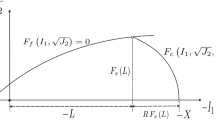Abstract
A fully implicit, fully coupled, and fully consistent finite element framework has been formulated in part I of this work for modeling reservoir compaction through linearizing coupled solid and flow field equations and constructing a local material integrator. In part II of this work, we focus on verification and performance analysis of our numerical formulation and computer implementation using several numerical examples. First, we design a cube problem in triaxial compression to verify our numerical formulation and computer code implementation especially for rock formation in compaction using cap plasticity models. The finite element prediction on stresses is compared with the analytical solution. The second problem we select is a strip footing problem popular in the geotechnical area where the evolution of soil consolidation degrees following the diffusion of pore pressure is the main interest. In this example, we demonstrate a good performance of the proposed numerical formulation on solving different shear and compaction-dominated deformation behaviors by varying the footing length. Importantly, an extremely sharp cap model based on real experimental data for Leda clays, a challenging cap model, is successfully applied in this footing problem. Our focus in this work is to model field reservoirs undergoing serious compaction. A reservoir with complex payzone geometries, multiple horizontal wells, and cap plasticity models with sharp cap surfaces has been successfully solved using our fully implicit formulation. The last example is to model a horizontal wellbore damage problem. Finally, the sensitivity of predicted subsidence to nonlinear flow model, cap hardening parameters, and Lode angles have been systemically investigated and documented in detail, which can provide a constructive guidance on how to successfully model field reservoir compaction problems with cap plasticity models.
Similar content being viewed by others
References
Pelessone, D.: A modified formulation of the cap model. Technical report No GA-C19579, Gulf Atomics (1989)
Mayuga, M.N.: Geology and development of California’s giant–Wilmington oil field. In: Geology of giant petroleum fields, American Association of Petroleum Geologists, Memoir, vol. 14, pp. 158–184 (1970)
Baade, R., Chin, L., Siemers, W.: Forecasting of Ekofisk reservoir compaction and subsidence by numerical simulation. J. Petrol. Technol. 47, 723–728 (1988)
Desai, C.S., Salami, M.: Constitutive model for rocks. J. Geotech. Engrg. 113, 407–423 (1987)
Nguyen, D.: Un concept de rupture unifie pour les materiaux rocheux denses et poreux. PhD thesis, Ecole Polytechnique de Montreal (1972)
Bier, W., Hartmann, S.: A finite strain constitutive model for metal powder compaction using a unique and convex single surface yield function. Eur. J. Mech. A-Solid 25, 1009–1030 (2006)
Rinehart, A., Broome, S.T., Dewers, T.: Mechanical variability and constitutive behavior at reservoir conditions of the Lower Tuscaloosa Formation supporting the SECARB Phase III CO2 Injection Program at Cranfield Site (No. SAND2014-20189J), Sandia National Laboratories. Albuquerque, New Mexico (2014)
Bigoni, D., Zaccaria, D.: Uniqueness and localization-I. Associative and non-associate elastoplasticity. J. Mech. Phys. Solids 40, 1313–1331 (1992)
Bigoni, D., Hueckel, T.: Loss of strong ellipticity in non-associative elastoplasticity. J. Mech. Phys. Solids 28, 197–213 (1991)
Foster, C.D., Regueiro, R.A., Fossum, A.F., Borja, R.I.: Implicit numerical integration of a three-invariant, isotropic/kinematic hardening cap plasticity model for geomaterials. Comp. Meth. Appl. Mech. Eng. 194, 5109–5138 (2005)
Liu, R., Lin, G., Bhashyam, G.: Transformation of the sandler and rubin nonsmooth cap model to the pelessone smooth cap model. J. Eng. Mech. 136, 680–685 (2009)
Motamedi, M.H., Foster, C.D.: An improved implicit numerical integration of a non-associated, three-invariant cap plasticity model with mixed isotropic–kinematic hardening for geomaterials. Int. J. Numer. Methods Eng. 39, 1853–1883 (2015)
Fredrich, J., Arguello, J., Thorne, B., Wawersik, W., Deitrick, G., De Rouffignac, E., Myer, L., Bruno, M.: Three-dimensional geomechanical simulation of reservoir compaction and implications for well failures in the Belridge Diatomite. SPE Paper 36698. Presented at SPE Annual Technical Conference and Exhibition, Denver, Colorado, 6-9 October (1996)
Bruno, M., Bovberg, C.: Reservoir compaction and surface subsidence above the Lost Hills Field, California. ARMA-92-0263. The 33th US Symposium on Rock Mechanics (USRMS), Santa Fe, New Mexico, 3-5 June (1992)
Mandel, J.: Consolidation Des Sols. Géotechnique 3, 287–299 (1953)
Cryer, C.: A comparison of the three-dimensional consolidation theories of Biot and Terzaghi. Quart. J. Mech. Appl. Math. 16, 401–412 (1963)
Fossum, A.F., Brannon, R.M.: On a viscoplastic model for rocks with mechanism-dependent characteristic times. Acta Geotech. 1, 89–106 (2006)
Brannon, R.M., Leelavanichkul, S.: A multi-stage return algorithm for solving the classical damage component of constitutive models for rocks, ceramics, and other rock-like media. Int. J. Fract. 163, 133–149 (2010)
Stupkiewicz, S., Denzer, R., Piccolroaz, A., Bigoni, D.: Implicit yield function formulation for granular and rock-like materials. Comput. Mech. 54, 1163–1173 (2014)
Brannon, R.M., Fossum, A.F., Strack, O.E.: Kayenta: theory and user’s guide (No. SAND2009-2282). Sandia National Laboratories, Albuquerque (2009)
Bardet, J.P.: Lode dependences for isotropic pressure-sensitive elastoplastic materials. J. Appl. Mech. 57, 498–506 (1990)
Bai, Y., Wierzbicki, T.: A new model of metal plasticity and fracture with pressure and Lode dependence. Int. J. Plast. 24, 1071–1096 (2008)
Author information
Authors and Affiliations
Corresponding author
Rights and permissions
About this article
Cite this article
Liu, Z., Liu, R. A fully implicit and consistent finite element framework for modeling reservoir compaction with large deformation and nonlinear flow model. Part II: verification and numerical example. Comput Geosci 22, 639–656 (2018). https://doi.org/10.1007/s10596-017-9716-2
Received:
Accepted:
Published:
Issue Date:
DOI: https://doi.org/10.1007/s10596-017-9716-2




